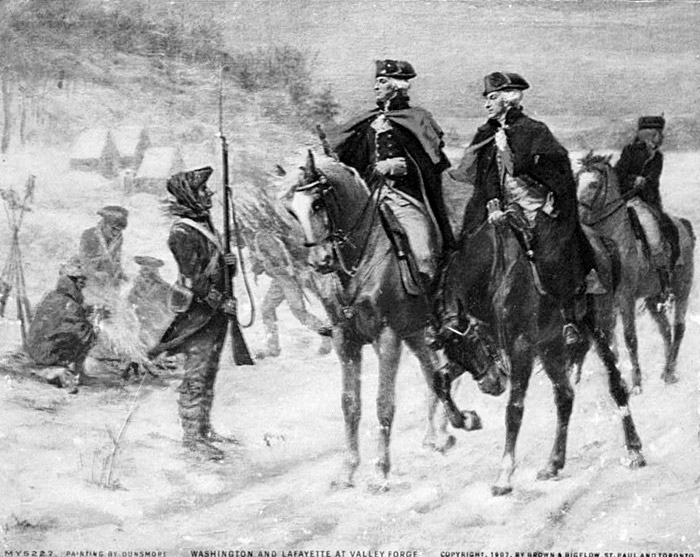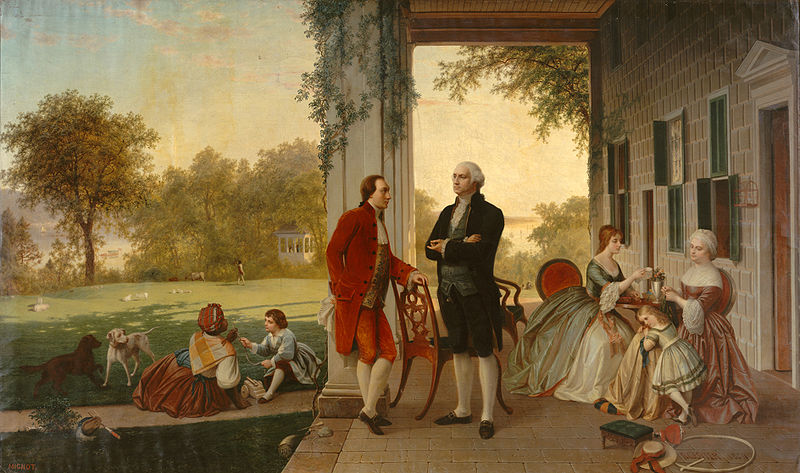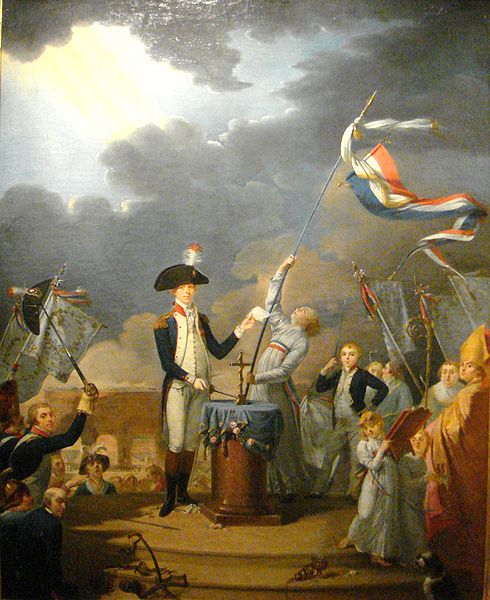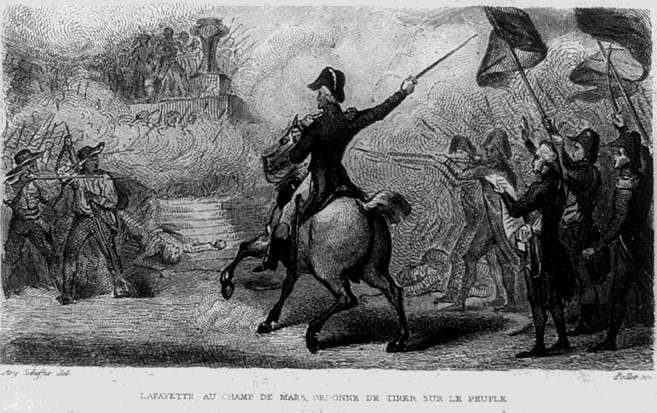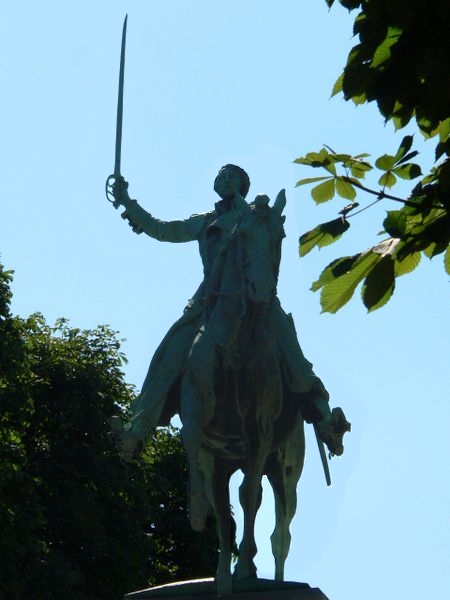<Back to Index>
- Chemist John Dalton, 1766
- Painter Friedrich Wilhelm Schadow, 1789
- General Marie Joseph Paul Yves Roch Gilbert du Motier, Marquis de La Fayette, 1757
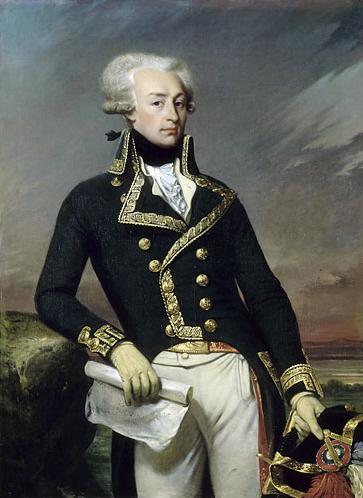
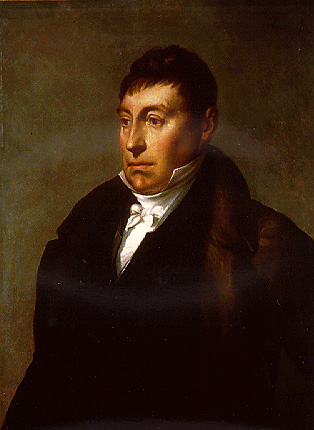
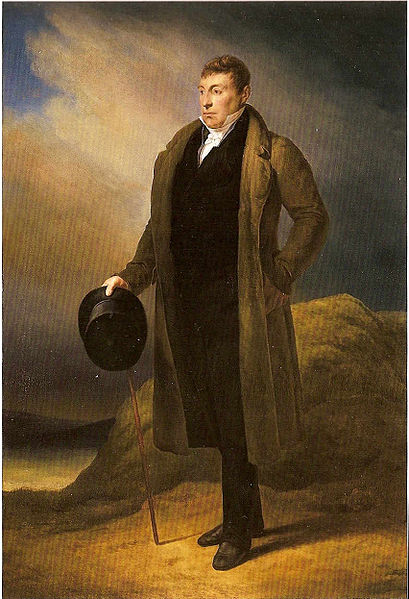
Marie-Joseph Paul Yves Roch Gilbert du Motier, Marquis de La Fayette (or Lafayette) (6 September 1757 – 20 May 1834) was a French aristocrat and military officer born in the province of Auvergne in south central France. Lafayette was a general in the American Revolutionary War and a leader of the Garde Nationale during the French Revolution.
In the American Revolution, Lafayette served in the Continental Army under George Washington. Wounded during the Battle of Brandywine, he still managed to organize a successful retreat. He served with distinction in the Battle of Rhode Island.
In the middle of the war, he returned to France to negotiate an
increased French commitment. On his return, he blocked troops led by Cornwallis at Yorktown while the armies of Washington and Jean-Baptiste Donatien de Vimeur, comte de Rochambeau, prepared for battle against the British. Back in France in 1788, Lafayette was called to the Assembly of Notables to respond to the fiscal crisis. Lafayette proposed a meeting of the French Estates-General,
where representatives from the three traditional classes of French
society — the clergy, the nobility and the commoners — met. He served
as vice president of the resulting body and presented a draft of the Declaration of the Rights of Man and of the Citizen. Lafayette was appointed commander-in-chief of the French (Garde nationale) National Guard in
response to violence leading up to the French Revolution. During the
Revolution, Lafayette attempted to maintain order, for which he
ultimately was persecuted by the Jacobins.
In 1791, as the radical factions in the Revolution grew in power,
Lafayette tried to flee to the United States through the Dutch
Republic. He was captured by Austrians and served nearly five years in
prison. Lafayette returned to France after Bonaparte freed him from an Austrian prison in 1797. He was elected to the Chamber of Deputies under the Charter of 1815, during the Hundred Days. With the Bourbon Restoration, Lafayette became a liberal member of the Chamber of Deputies in 1815, a position he held until his death. In 1824, President James Monroe invited
Lafayette to the United States as the "nation's guest"; during the
trip, he would visit all of the then twenty-four states. For his
contributions to the American Revolution, many cities and monuments
throughout the United States bear his name (Fayetteville, North Carolina, was the only one of those he actually visited in person), and he was the first person granted honorary United States citizenship. During France's July Revolution of 1830 Lafayette declined an offer to become the French dictator; instead he supported Louis-Philippe's bid as a constitutional monarch. Lafayette died on 20 May 1834, and is buried in Picpus Cemetery in Paris, under soil from the Revolutionary War battlefield Bunker Hill. Lafayette was born on 6 September 1757 to Michel Louis Christophe Roch Gilbert Paulette du Motier, marquis de La Fayette, colonel aux Grenadiers de France, and Marie Louise Jolie de La Rivière, at the château de Chavaniac, in Chavaniac, near Le Puy-en-Velay, in the modern department of Haute-Loire. His
full name is rarely used; instead he is often referred to as the
marquis de La Fayette or Lafayette. Biographer Louis Gottschalk
asserted that Lafayette indifferently spelled his name both Lafayette
and LaFayette. Lafayette's lineage appears to be one of the oldest in Auvergne. In this area members of the family were known for their contempt for danger. Lafayette's ancestor, Marshal of France Gilbert de La Fayette III, was a companion-at-arms who led Joan of Arc's army in Orléans. His great-grandfather was the comte de La Rivière, a former lieutenant general in the Royal Armées. According to legend, another ancestor acquired the Crown of Thorns during the 6th Crusade. Lafayette's uncle Jacques-Roch died fighting the Austrians and left the marquis title to Lafayette's father. Lafayette's father, struck by a cannonball at the Battle of Minden in Westphalia, died on 1 August 1759. Lafayette became Lord of Chavaniac, but the estate went to his mother.
Lafayette's mother and his maternal grandfather, marquis de La Rivière, died, on 3 April and 24 April 1770 respectively,
leaving Lafayette an income of 25,000 livres. Upon the death of an uncle, the 12-year-old Lafayette inherited a handsome yearly sum of 120,000 livres. Lafayette
was raised by his paternal grandmother, Mme de Chavaniac, who had
brought the château into the family with her dowry. Also in the
household were Mme de Chavaniac's daughters Madeleine de Motier, and
Charlotte Guérin, the baronne de Chavaniac. Lafayette's
mother decided that the family's heir necessitated proper schooling in
Paris rather than at-home tutoring by the Abbé Fayon. Hence, at
the age of eleven, he entered the Collège du Plessis, a school for boys of the aristocracy. He studied military matters at the Versailles Academy and, on 9 April 1771, was commissioned as a sous-lieutenant (second Lieutenant) in the Mousquetaires. The Mousquetaires program
was eventually dismantled due to the high cost of running operations
and the growing concern for spending. This was met with positive and
negative opinions by the aristocracy. The Musketeers were often used
for protection of the royalty. Through an arranged marriage, he wed Marie Adrienne Françoise de Noailles, the daughter of the wealthy Jean-Paul-François, 5th duc de Noailles.
On 14 March 1774, Louis XV signed the marriage contract, and the
wedding took place on 11 April; Lafayette's father-in-law gave him a
dowry of 400,000 livres, the rank of captain, and command of a company
in the Noailles Dragoons Regiment. In 1775, Lafayette took part in his unit's annual training in Metz, where he met Charles-François, comte de Broglie, the Army of the East's commander and a superior. When the Duke of Gloucester, King George III's brother and colonial policy critic, travelled through the region, he was invited to dinner with de Broglie and his men. Lafayette wrote in his memoirs that at this dinner when he ...first learned of that quarrel, my heart was enlisted and I thought only of joining the colors. Lafayette returned to Paris in the fall and participated in sociétés de pensée (thinking groups) that discussed French involvement in the American Revolution. At these meetings, a frequent speaker, Abbé Guillaume Raynal emphasised
the "rights of man". He criticised the nobility, the clergy and the
practice of slavery. The monarchy banned Raynal from speaking, and he
expressed his views secretly in the Masonic Lodges of which Lafayette
was a member. On 7 December 1776, Lafayette arranged through Silas Deane, an American agent in Paris, to enter the American service as a major general. Lafayette visited his uncle Marquis de Noailles, the Ambassador to Britain, as he promised. During a ball at Lord George Germain's, he met Lord Rawdon, met Sir Henry Clinton at the Opera, and met Lord Shelburne at breakfast. However, Lafayette refused to toast King George, and left after three weeks. In 1777, the French government granted the American military one million livres in supplies after Minister Charles Gravier pressed for French involvement. De Broglie intrigued with his old subordinate, German Johann de Kalb, (who had previously done a reconnaissance of America), to send French
officers to fight alongside the Americans, (and perhaps set up a French generalissimo). De
Broglie approached Gravier, suggesting assistance to the American
revolutionaries. De Broglie then presented Lafayette, who had been
placed on the reserve list, to de Kalb.
Going back to Paris, Lafayette found that the Continental Congress did not have the money for his voyage; hence he acquired the sailing ship La Victoire himself. The
king officially forbade him to leave after British spies discovered his
plan, and issued an order for Lafayette to join his father-in-law's
regiment in Marseille, disobedience
of which would be punishable by imprisonment. The British ambassador
ordered the seizure of the ship Lafayette was fitting out at Bordeaux,
and Lafayette was threatened with arrest. He
eluded capture disguised as a courier, and travelled to Spain. On 20
April 1777, he sailed for America with eleven companions, leaving his pregnant wife in France. The ship's captain intended to stop in the West Indies to sell cargo; however Lafayette, fearful of arrest, bought the cargo to avoid docking at the islands. He landed on North Island near Georgetown, South Carolina, on 13 June 1777. On arrival, Lafayette met Major Benjamin Huger, with whom he stayed for two weeks before departing on the thirty-two day journey to Philadelphia. In Pennsylvania, the Continental Congress delayed Lafayette's
commission, as they had tired of "French glory seekers" and other men
sent by Silas Deane. Congress, impressed by Lafayette's offer to serve
without pay, commissioned the rank of major-general on 31 July 1777. The
commission, however, became effective on that date, not from his
original agreement with Deane. In addition, he was not assigned a unit;
he nearly returned home for this reason. Benjamin Franklin, however, wrote George Washington recommending acceptance of Lafayette as his aide-de-camp, hoping it would influence France to commit more aid. Washington accepted, and Lafayette met him at Moland House in Bucks County, Pennsylvania on 10 August 1777. When
Washington expressed embarrassment to show a French officer the state
of their camp and troops, Lafayette responded, "I am here to learn, not
to teach." He
became a member of Washington's staff, although confusion existed
regarding his status. Congress regarded his commission as honorary,
while he considered himself a full-fledged commander who would be given
control of a division, when Washington deemed him prepared. To address
this, Washington told Lafayette that a division would not be possible
as he was of foreign birth; however, Washington said that he would be
happy to hold him in confidence as "friend and father". Lafayette's first battle was at Brandywine on 11 September 1777, which was lost. After the British outflanked the Americans, Washington acquiesced to a request by Lafayette to join General John Sullivan. Upon his arrival, Lafayette went with the Third Pennsylvania Brigade, under Brigadier Thomas Conway and attempted to rally the unit to face the attack. In face of the British and Hessian numeric
superiority, Lafayette was shot in the leg. During the American
retreat, Lafayette created a control point allowing a more orderly
retreat before being treated for his wound. After
the battle, Washington cited him for "bravery and military ardour" and
recommended him for the command of a division in a letter to Congress.
Lafayette returned to the field in December after two months of rest,
and received command of Major General Adam Stephen's division. He assisted General Nathanael Greene in
reconnaissance of British positions in New Jersey; with
300 soldiers, he defeated a numerically superior Hessian force in Gloucester on 24 November 1777. He returned to Valley Forge for the winter, where the Horatio Gates led War Board asked him to prepare an invasion of Canada from Albany, New York. Thomas Conway hoped to replace Washington with Gates, who had been successful in the Battle of Saratoga. He concocted a plot known as the Conway Cabal which separated Washington from Lafayette, one of Washington's firmest supporters. Lafayette alerted Washington of his suspicions about the plot before leaving. When
Lafayette arrived in Albany, he found too few men to mount a Canadian
invasion in the winter. He wrote to Washington of the situation, and
made plans to return to Valley Forge. Before departing, he recruited the Oneida tribe, who referred to Lafayette as Kayewla (fearsome horseman), to the American side. In
Valley Forge, he vocally criticised the War Board's decision to attempt
an invasion of Canada in the winter. The Continental Congress agreed
and Gates was removed from the Board. Meanwhile,
treaties signed by America and France were made public in March 1778,
and France formally recognised American independence. After
France entered the war, the Americans tried to sense what the British
forces' reaction would be. On 18 May 1778, Washington dispatched
Lafayette with a 2,200 man force to reconnoitre near Barren Hill,
Pennsylvania. The next day, the British heard that Lafayette had made
camp nearby and sent 5,000 men to capture him for his symbolic
value representing the Franco-American alliance. On 20 May, General
Howe led a further 6,000 soldiers and ordered an attack on
Lafayette's left flank. The flank scattered, and Lafayette organised a
retreat while the British remained indecisive. To feign numerical
superiority, he ordered men to appear from the woods on an outcropping
known as Barren Hill (now Lafayette Hill) and to fire upon the British periodically. Lafayette's troops simultaneously escaped via a sunken road. Lafayette was then able to cross Matson's Ford with the remainder of his force. Unable
to trap Lafayette, the British resumed their march north from
Philadelphia to New York; the Continental Army, including Lafayette,
followed and finally attacked at the Monmouth Courthouse. At
Monmouth, Washington appointed General Lee to lead the attacking force.
On 28 June, Lee moved against the British flank; however, soon after
fighting began, he began acting strangely. Lafayette sent a message to
Washington to urge him to the front; upon his arrival he found Lee's
men in retreat. Washington was able to rally the American force and
repel two British attacks. Due to the day's heat, fighting ended early
and the British withdrew in the night. The French fleet arrived in America on 8 July 1778 under Admiral d'Estaing, with whom General Washington planned to attack Newport, Rhode Island.
Lafayette and General Greene were sent with a 3,000-man force to
participate in the attack. Lafayette wanted to control a joint
Franco-American force in the attack but was rebuffed. On 9 August, the
American force attacked the British without consulting d'Estaing. When
the Americans asked the admiral to leave his fleet in Narragansett Bay, d'Estaing refused and attacked the British under Lord Howe. The attack dispersed the British fleet, but a storm damaged the French ships. D'Estaing
moved his ships north to Boston for repairs. When the fleet arrived,
Bostonians rioted because they considered the French departure from
Newport a desertion. John Hancock and
Lafayette were dispatched to calm the situation, and then Lafayette
returned to Newport to prepare for the retreat made necessary by
d'Estaing's departure. For these actions, Lafayette was cited by the
Continental Congress for "gallantry, skill and prudence". However he
realised that the Boston riot might undermine the Franco-American
alliance in France, so he requested and was given permission to return
to France. In
February 1779, Lafayette returned to Paris. For disobeying the king by
going to America, he was placed under house arrest for two weeks.
Nevertheless, his return was triumphant. Benjamin
Franklin's grandson presented him with a 4,800 livre
gold-encrusted sword commissioned by the Continental Congress, and the
king asked to see him. Louis XVI, pleased with the soldier after Lafayette proposed schemes for attacking the British, restored his position in the dragoons.
Lafayette used his position to lobby for more French aid to America.
Working with Franklin, Lafayette secured another 6,000 soldiers to
be commanded by General Jean-Baptiste de Rochambeau. Lafayette received news that Adrienne had borne him a son, Georges Washington Lafayette. After
his son's birth, he pushed for additional commitments of support from
France for the American Revolutionary War. He ordered new uniforms and
arranged for the fleet's departure. Before returning to America,
Lafayette and the French force learned that they would be operating
under American command, with Washington in control of military
operations. In March 1780, Lafayette gave power of attorney to business manager Jacques-Philippe Grattepain-Morizot and Adrienne, and left France, departing for the Americas aboard the Hermione, from the harbour of Rochefort.
He arrived in Boston on 28 April carrying the then secret news that he
had secured French reinforcements (5,500 men and 5 frigates) for George
Washington. Lafayette returned to America in May 1781 and was sent to Virginia to defend against Benedict Arnold and to replace Baron von Steuben. Lafayette evaded Cornwallis' attempts to capture him in Richmond. In
June, Cornwallis received orders from London to proceed to the
Chesapeake Bay and to oversee construction of a port, in preparation of
an attack on Philadelphia. As
the British column travelled, Lafayette followed in a bold show of
force that encouraged new recruits. In June, Lafayette's men were
joined by forces under General (Mad) Anthony Wayne.
Soldiers deserted both leaders; Wayne executed six for desertion.
Lafayette offered to release his men from service because of the great
danger ahead; all of his men remained. On 4 July, the British decamped at Williamsburg and prepared to cross the James River. Cornwallis sent only an advance guard across the river, with intentions to trap, should Lafayette attack. Lafayette ordered Wayne to strike on
6 July with roughly 800 soldiers. Wayne found himself vastly
outnumbered against the full British force and, instead of retreating,
led a bayonet charge. The charge bought time for the Americans, and
Lafayette ordered the retreat. The British did not pursue. The result
was a victory for Cornwallis, but the American army was bolstered from
the display of courage by the men. By August, Cornwallis had established the British at Yorktown, and Lafayette took up position on Malvern Hill. This manoeuvre trapped the British when the French fleet arrived. On
14 September 1781, Washington's forces joined Lafayette's, which had
succeeded in containing the British until supplies and reinforcements
arrived. On 28 September, with the French fleet blockading the British,
the combined forces attacked in what became known as the Siege of
Yorktown. Lafayette's detail formed the right end of the American wing,
the 400 men of which took redoubt 10, in hand-to-hand combat. After a failed British counter-attack, Cornwallis surrendered on 19 October 1781. Lafayette
returned to France on 18 December 1781 from Boston. He was welcomed as
a hero, and on 22 January 1782, he was received at Versailles. He witnessed the birth of his daughter, whom he named Marie-Antoinette Virginie upon Thomas Jefferson's recommendation. He was promoted to maréchal de camp, skipping numerous ranks. Lafayette
then helped prepare for a combined French and Spanish expedition, of
which he was appointed chief-of-staff, against the British West India
Islands. The Treaty of Paris signed between Great Britain and the U.S. on 20 January 1783 made the expedition unnecessary. In
France, Lafayette worked with Thomas Jefferson to organize trade
agreements between the United States and France. These negotiations
aimed to reduce debt owed to France by the U.S., and included
commitments on tobacco and whale oil. He joined the French abolitionist group Society of the Friends of the Blacks,
which advocated for ending slave trade and equal rights for free
blacks. In 1783, in correspondence with Washington, he urged the
emancipation of slaves; and to establish them as farmer tenants. Although Washington demurred, Lafayette purchased land in the French colony of Cayenne for his plantation La Belle Gabrielle, to "experiment" with education, and emancipation. In 1782 Lafayette returned to America, and visited all of the states except Georgia. The trip included a visit to Washington's farm at Mount Vernon on
17 August. In Virginia, Lafayette addressed the House of Delegates and
prayed for "liberty of all mankind"; and urged emancipation. Lafayette advocated to the Pennsylvania Legislature for a federal union, and visited the Mohawk Valley in New York for peace negotiations between the Iroquois, some of whom had met Lafayette in 1778. Lafayette
received an honorary degree from Harvard, a portrait of Washington from
the city of Boston, and a bust from the state of Virginia. Maryland's
legislature honored him by making Lafayette and his male heirs "natural
born Citizens" of the state, which made him a natural born citizen of the United States after ratification of the new national Constitution. Connecticut, Massachusetts, and Virginia also granted him honorary citizenship. Upon
his return to France, Historian Louis Gottschalk concluded that
Lafayette became involved in an affair with the comtesse Aglaé
d'Hunolstein, that he broke off on 27 March 1783 by letter, at the insistence of her family. He
became briefly linked amorously to Madame de Simiane; however, scholars
are divided, whether Adrienne knew of these two extramarital affairs. Enemies of Lafayette made much of the court gossip. Through the next years, Lafayette was active in the Hôtel de La Fayette, in the rue de Bourbon, the headquarters of Americans in Paris, Benjamin Franklin, Mr. and Mrs. John Jay, and Mr. and Mrs. John Adams, who met every Monday, and dined in company with family and the liberal nobility, such as Clermont-Tonnerre, and Madame de Staël. King Louis XVI convoked the Assembly of Notables on 29 December 1786, in response to France's fiscal crisis.
The King appointed Lafayette to the body, in the comte d'Artois'
division, which met on 22 February 1787. Lafayette argued against
proposed higher taxation to solve the economic problems, and supported
measures to curb spending. He called for a "truly national assembly", which represented the three classes of French society: clergy, nobility, and commons. On 8 August 1788, the King agreed to hold an Estates General the next year. Lafayette was elected to represent the nobility (Second Estate) from Riom in the Estates General. The
Estates General convened on 5 May 1789; debate began on whether the
delegates should vote by head or by Estate. If voting was by Estate
then the nobility and clergy would be able to overturn the commons; if
by head, then the larger Third Estate could dominate. Before the
meeting, he agitated for the voting by headcount, rather than estate,
as a member of the "Committee of Thirty". The
issue did not resolve and, on 1 June, the Third Estate asked the others
to join them. From 13 to 17 June many of the clergy and some of the
nobility did so; on the 17th, the group declared itself the National Assembly. Three days later the doors to their chambers were locked. This led to the Tennis Court Oath, where the members swore to not separate until a Constitution was established. Lafayette,
along with forty-six others, joined the National Assembly and, on 27
June, the remainder followed. On 11 July 1789, Lafayette presented a
draft of the "Declaration of the Rights of Man and of the Citizen". The next day, after dismissal of Finance Minister Jacques Necker, Camille Desmoulins organised an armed mob. The King had the Royal Army under the 2nd duc de Broglie surround Paris. On 13 July, the Assembly elected him their vice-president; the following day the Bastille was stormed. On 15 July, Lafayette was acclaimed commander-in-chief of the National Guard of France, an armed force established to maintain order under the control of the Assembly. Lafayette proposed the name and the symbol of the group: a blue, white and red cockade. On 5 October 1789, a Parisian crowd, comprised mostly of women, marched to Versailles in
response to the scarcity of bread. Lafayette and members of the
National Guard followed the march. At Versailles, the king accepted the
Assembly's votes but refused requests to return to Paris. That evening,
Lafayette replaced most of the royal bodyguards with National
Guardsmen. At dawn, the crowd broke into the palace. Before it
succeeded in entering the queen's bedroom, Marie Antoinette fled to the king's apartments. Lafayette took the royal family onto the palace balcony and attempted to restore order. The crowd insisted that the king and his family move to Paris where they were installed in the Tuileries Palace. As leader of the National Guard, Lafayette attempted to maintain order. On 12 May 1790, he instituted, along with Jean Sylvain Bailly (mayor
of Paris), a political club called the "Society of 1789" . The club's
intention was to provide balance to the influence of the Jacobins. On 14 July 1790, Lafayette took the civic oath on the Champ de Mars,
vowing to "be ever faithful to the nation, to the law, and to the king;
to support with our utmost power the constitution decreed by the
National Assembly, and accepted by the king." He continued to work for order through the coming months. On 20 February 1791, the Day of Daggers,
Lafayette traveled to Vincennes in response to an attempt to liberate a
local prison. Meanwhile, armed nobles converged around the Tuileries, afraid the unprotected king would be attacked. Lafayette returned to Paris to disarm the nobles. On 18 April, the National Guard disobeyed Lafayette and stopped the King from leaving for Saint-Cloud over Easter. On 20 June 1791, an unsuccessful plot, called the Flight to Varennes,
nearly allowed the king to escape from Paris. As leader of the National
Guard, Lafayette had been responsible for the royal family's custody.
He was thus blamed by Danton for the mishap and called a "traitor" to the people by Maximilien Robespierre. These accusations portrayed Lafayette as a royalist, and damaged his reputation in the eyes of the public. The episode garnered support throughout the country for the Republican movement, and "polarized" the king's supporters. Through the latter half of 1791, Lafayette's stature continued to decline. On 17 July, the Cordeliers organized an event, at the Champ de Mars, to gather signatures on a petition which called for a referendum on Louis XVI. The
assembled crowd, estimated to be up to 10,000, hanged two men believed
to be spies after they were found under a platform. In response, the
Assembly asked Bailly, the mayor of Paris, to "halt the disorder"; martial law was declared; and National Guard troops, under Lafayette, marched to the scene. Lafayette,
at the head of the column, carried a red flag to signify martial law.
The National Guard under Lafayette tried to disperse the crowd without
the use of violence. The National Guards first attempts were successful
and the crowd dissipated. However, later that same day it massed again. This was in part due to speeches given by Georges Danton and Camille Desmoulins.
At some point stones were then thrown at the troops. Lafayette at this
point is thought to have ordered his troops to fire warning shots into
the air. When the crowd did not back down, Lafayette ordered his men to
fire into the crowd. The National Guard was comprised substantially of
volunteers. Senior Officers in the National Guard questioned after the
event stated they found it hard to control the actions of the volunteer
soldiers. Many injuries were reported though not all were fatal. This
is generally thought to have been due to the disorganization and
inexpert actions taken by the National Guard in the quelling of the
disorder. Exact numbers of deaths are unknown; estimates generally
range from a dozen to fifty. Because of these confusions, the sequence of events at the Champ de Mars remains unclear and contested. In combination with the Flight to Varennes, this event, known as the Champ de Mars Massacre (Fusillade du Champ de Mars),
furthered the public's mistrust in Lafayette and Bailly; in the
aftermath, Lafayette resigned his National Guard command and Bailly
vacated his post as mayor. In November, Lafayette ran against Jérôme Pétion de Villeneuve in
the mayoral election to succeed Bailly. He lost his campaign against
Villeneuve by a large margin. Criticisms plagued Lafayette's mayoral
campaign: his roles in the flight to Varennes and the Champ de Mars
massacre were denounced both by politicians on the left and right. Lafayette returned to Auvergne following the loss of the mayoral election. France declared war on Austria on 20 April 1792,
and preparations to invade the Austrian Netherlands were begun;
Lafayette received command of one of the three armies, at Metz. The
war proceeded poorly: Lafayette, along with Rochambeau and Luckner,
asked the Assembly to begin peace proceedings, as the generals feared
the army would collapse if forced to attack. In
June 1792, Lafayette criticized the growing influence of the radical
clubs through a letter to the Assembly from his field post, and ended his letter by calling for radical parties to be "closed down by force". Earlier,
in May, he had secretly proposed to a Brussels diplomat that the war be
stopped until he achieved peace in Paris, perhaps by force. Lafayette's
prior actions, despite the proposal's secrecy, caused suspicions that
he planned a coup d’état. Marie-Antoinette advised authorities of Lafayette's plan, since she did not favor the constitution. Lafayette
left his command and returned to Paris on 28 June, where he asked the
Assembly for the radical parties to be outlawed, the National Guard to
defend the monarchy, and for the Constitution to be upheld. His return augmented suspicions that he planned a coup d’état. Again, Lafayette and the Feuillants proposed
to save the constitutional monarchy and royal family by uniting his
army with General Luckner's. Marie-Antoinette refused: Lafayette had
lost the support of the monarchy and the radical parties of the
Revolution. On 8 August, a vote of impeachment was held against him for
abandoning his post, in which more than two thirds voted against. Two days later, on 10 August,
a mob attacked the Tuileries. The king and his family were brought
under guard to the Legislative Assembly who suspended Louis XVI and
convoked the National Convention. Commissioners dispatched by the Paris Commune arrived at Sedan,
where Lafayette now led his army, to inform him of the events and to
secure allegiance to the new government. Lafayette refused their offer
of an executive role in the new government, and ordered them arrested,
as he found them to be "agents of a faction which had unlawfully seized
power." New
commissioners came to Sedan and informed Lafayette that he had been
relieved of his command. On 19 August, the Assembly declared Lafayette
a traitor. Lafayette
and a group of supporters decided to flee for the Dutch Republic.
Lafayette hoped to escape to the United States or to rally
Constitutional supporters, but did not make it; the Austrians under Field Marshall Moitelle, arrested him at Rochefort, Belgium. Among those arrested with him were Jean Baptiste Joseph, chevalier de Laumoy, Louis Saint Ange Morel, chevalier de la Colombe, Alexandre-Théodore-Victor, comte de Lameth, Charles César de Fay de La Tour-Maubourg, Marie Victor de Fay, marquis de Latour-Maubourg, Juste-Charles de Fay de La Tour-Maubourg, Jean-Xavier Bureau de Pusy. Several days later, the prisoners were handed over to Prussia and imprisoned at the citadel of Wesel, where La Fayette became ill. From 25 August to 3 September 1792, he was held at Nivelles; then at Coblentz from 16 to 29 September 1794; at Magdeburg from 15 March 1793 to 22 Jan 1794; at Neisse from 16 February 1794 to 16 May 1794, and finally moved to Olmutz around 25 July 1794, where he was incarcerated in a dungeon. On
17 September 1792, soldiers placed Lafayette's wife, Adrienne, under
house arrest. Adrienne sold her property and appealed to the Americans
for assistance. For political reasons, the young nation could not
officially assist the family, although they retroactively paid
Lafayette $24,424 for his military service, and Washington personally
sent financial aid. In May 1794, during the Reign of Terror, she was transferred to the La Force Prison in Paris; she went from prison to prison until her release on 22 January 1795. Adrienne organized the family's finances, including the sale of her property, and
appealed to the U.S. for American passports. James Monroe secured
passports for Adrienne from Connecticut, which had granted the entire
Lafayette family citizenship. Their son Georges, who was hiding to
avoid execution, was sent to the U.S. She, however, continued to Vienna for an audience with Emperor Francis II, who granted permission for her to live with Lafayette in captivity. Adrienne lived in his cell with him and finally, in September 1797, after five years' imprisonment, Napoleon Bonaparte and the Directory negotiated the release of the family, as a part of the Treaty of Campo Formio, drafted in 1797. Lafayette was not allowed to return to France until 1799, after Napoleon Bonaparte's coup d'état of 18 Brumaire, when Adrienne obtained permission for his return. On return, Lafayette,
averse to serving in Napoleon's army, resigned his commission. They retired to La Grange, property of her mother's, which Adrienne had recovered, and where Charles James Fox came to visit. Lafayette
was unwilling to compromise with Napoleon's government; thus he stayed
away from a government that he viewed as illegitimate, in Paris. In
1804, Napoleon was crowned Emperor, after a plebiscite in which
Lafayette did not participate. He remained relatively quiet, although
he spoke publicly on Bastille Day events. After the Louisiana Purchase,
Jefferson asked if he would be interested in the governorship.
Lafayette declined, citing personal problems and the desire to work for
liberty in France. During
a trip to Auvergne, Adrienne became ill. Due to her malady, worsened by
the scurvy she had contracted in prison, she was unable to hide her
anemia. In 1807, she became delirious but recovered enough on Christmas
Eve to gather the family around her bed and to say to Lafayette: "Je suis toute à vous" ("I am all yours"). She died the next day, apparently from lead-poisoning complications. He was elected to the Chamber of Representatives under the Charter of 1815, during the Hundred Days, which called for Napoleon to abdicate after Waterloo. Lucien Bonaparte, came before the assembly to denounce abdication, Lafayette replied: By
what right do you dare accuse the nation of...want of perseverance in
the emperor's interest? The nation has followed him on the fields of
Italy, across the sands of Egypt and the plains of Germany, across the
frozen deserts of Russia.... The nation has followed him in fifty
battles, in his defeats and in his victories, and in doing so we have
to mourn the blood of three million Frenchmen. Louis XVIII and the ultra-royalists became increasingly repressive. In 1823, he was involved in the Saint-Amand Bazard conspiracy, in the premature Charbonnerie insurrection at Belfort. France intervened in the Spanish Civil War, 1820–1823, increasing patriotism, and discredited dissent. In 1825 Charles X was crowned, and the ultra-loyalists consolidated power.
President
James Monroe invited Lafayette to visit the United States from August
1824 to September 1825, in part to celebrate the nation's
50th anniversary. During his trip, he visited all of the American states and travelled more than 6,000 miles (9,656 km). Lafayette arrived from France at Staten Island, N.Y., on 15 August 1824, to an artillery salute. The towns and cities he visited, including Fayetteville, North Carolina, the first city named in his honour, gave him enthusiastic welcomes. On
17 October 1824, Lafayette visited Mount Vernon and George Washington's
tomb. On 4 November 1824, he visited Jefferson at Monticello, and on
the 8th he attended a public banquet at the University of Virginia. In late August 1825, he returned to Mount Vernon. A military unit decided to adopt the title National Guard, in honour of Lafayette's celebrated Garde Nationale de Paris. This battalion, later the 7th Regiment, was prominent in the line of march when Lafayette passed through New York before returning to France on the frigate USS Brandywine. Late in the trip, he again received honorary citizenship of Maryland. Lafayette was feted at the first commencement ceremony of George Washington University in 1824. He was voted, by the U.S. Congress, the sum of $200,000 and a township of land located in Tallahassee, Florida, to be known as the Lafayette Land Grant.
As the restored monarchy of Charles X became more conservative, Lafayette re-emerged as a prominent public figure. He had been a member of the Chamber of Deputies from Seine-et-Marne since 1815 and had pursued the abdication of Napoleon. Throughout
his legislative career, he continued to endorse causes such as freedom
of the press, suffrage for all taxpayers, and the worldwide abolition
of slavery. He
was not as directly visible in public affairs as in previous years;
however, he became more vocal in the events leading up to the July Revolution of 1830. When the monarch proposed that theft from churches be made a capital crime, agitation against the Crown increased. On
27 July 1830, Parisians began erecting barricades throughout the city,
and riots erupted. Lafayette established a committee as interim
government. On 29 July 1830, the commission asked Lafayette to become
dictator, but he demurred to offer the crown to Louis-Philippe.
Lafayette was reinstated as commander of the National Guard by the new
monarch, who revoked the post after Lafayette once again called for the
abolition of slavery. Lafayette
spoke for the last time in the Chamber of Deputies on 3 January 1834.
The winter was wet and cold, and the next month he collapsed at a
funeral from pneumonia. Although he recovered, the following May was wet and, after a thunderstorm, he became sick and bedridden. On 20 May 1834, Lafayette died. He was buried next to his wife at the Cimetière de Picpus under soil from Bunker Hill, which his son Georges sprinkled upon him. King
Louis-Phillipe ordered a military funeral in order to keep the public
from attending. Crowds formed to protest their exclusion from
Lafayette's funeral.
American
President Andrew Jackson ordered that Lafayette be accorded the same
funeral honours as John Adams and George Washington. Therefore, 24-gun
salutes were fired from military posts and ships, each shot
representing a U.S. state. Flags flew at half mast for thirty-five
days, and "military officers wore crape for six months". The Congress hung black in chambers and asked the entire country to dress in black for the next thirty days.
